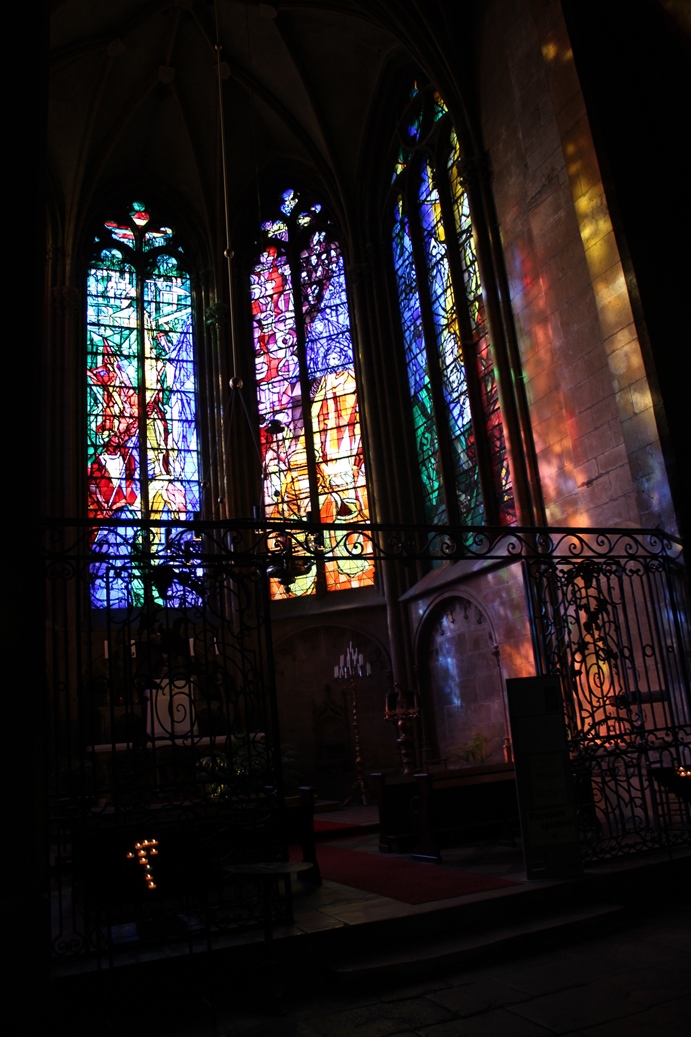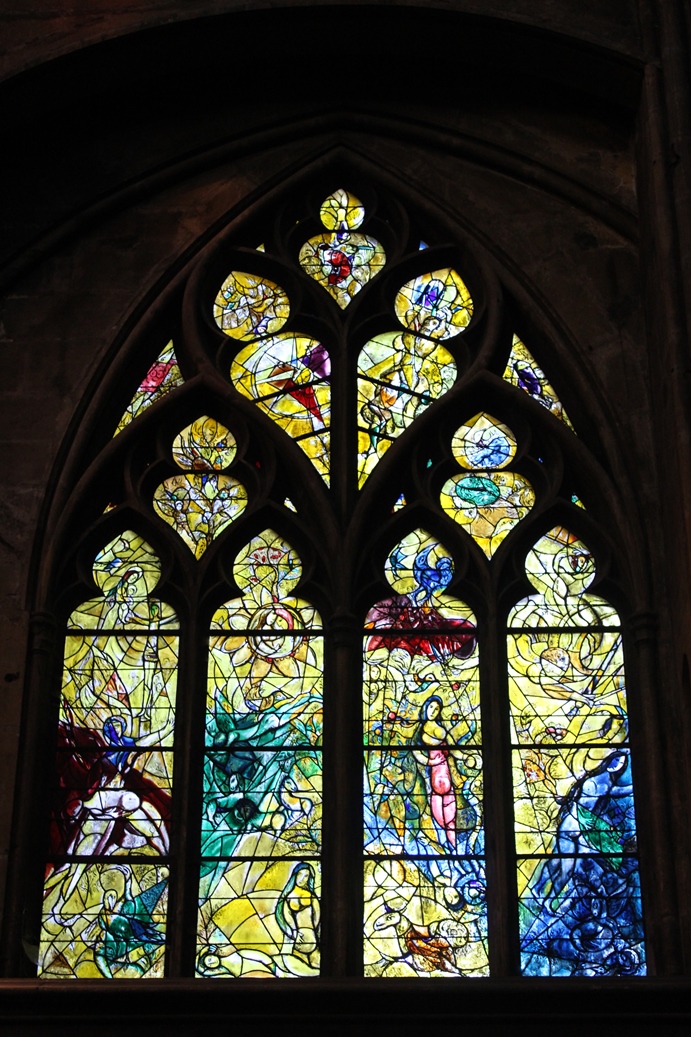France: Metz Cathedral
France: Metz Cathedral
by Jonathan Evens
Nicknamed “God’s Lantern,” Metz Cathedral in Lorraine, France, is renowned for its vast expanse of stained glass—covering 6,496 square meters, i.e. over twice as much as Rouen and three times as much as Chartres. The amount is impressive, but so too is its variety. It dates from the thirteenth century all the way through to the 1960s.
In the book All the Cathedrals of France (London: Unicorn Press, 2002), Basil Cottle notes that the glass at Metz “is not stylistically co-ordinated; its assembly has been by slow growth, and many hands have participated, with many colours and iconographic schemes.” Yet, the “effect on entering the nave is dazzling: three tiers of windows, including the richly glazed triforium; extremely tall and acute-angling vaulting and apse windows, and a grove of slim clustered shafts receding eastwards into pools of colours.”
The cathedral offers visitors a simple but effective leaflet, Parcours spiritual, that identifies a prayerful route around the cathedral, highlighting sixteen of its most important aspects, including its modern glass. At each of these points in the cathedral, information and a prayer can be found, encouraging visitors to be not simply tourists but worshippers as well. Some argue that this approach, like the information provided on wall cards in museum exhibitions, might direct viewers to see the artwork from one perspective alone. However, this does not have to be the case, as viewers often take that perspective as a starting point for then seeing others. Curators have found that providing no way into an artwork can leave viewers unable to begin to engage with the artwork at all.
Marc Chagall came to stained glass relatively late in his career with the commissions for the baptistery at Notre-Dame-de-Toute-Grâce du Plateau d’Assy completed in 1957. A result of his friendship with Marie-Alain Couturier these included two small windows in grisaille—one of an angel holding a jug of holy water, the other of an angel with a candelabra and flowers. Chagall, as a Jew, had reservations about fulfilling commissions for a Christian church to the extent that he insisted the phrase “In the Name of the Liberty of All Religions” be placed on the baptistery mural.
Following this commission, however, Chagall—working with Charles Marq from the Atelier Simon Marq—received many church commissions for stained glass, the ambulatory windows for Metz Cathedral, realized in 1960, being the first of these commissions. According to the Israel Review of Arts and Letters, “Marq developed a special process of veneering pigment on glass, which allowed Chagall to use as many as three colours on a single uninterrupted pane rather than being confined to the traditional technique of separating each colour by lead strips.”
Chagall was inspired by both the Bible and his visits to Israel. Accompanied by his wife Bella and his daughter Ida, Chagall first went to Israel in 1931. The main reason for this visit was a commission he had received from the Parisian art dealer and publisher Ambroise Vollard to do a series of illustrations for the Bible. Chagall traveled throughout the country a great deal, painting and drawing in Tel Aviv, Jerusalem, and Safed. Israel left a vivid impression on him, and back in Paris, the light and landscape he had seen were echoed in many of his etchings for The Bible. In 1951, the opening of large retrospective exhibitions of Chagall’s works in Jerusalem, Haifa, and Tel Aviv prompted his second visit to Israel. The publication of his illustrations to the Bible brought him to Israel a third time in 1957. Vollard had died shortly before World War II, so Tériade published the commission that had finally been completed in 1956. Also in that year, a second book of Bible illustrations was published by Vervé.
“In the East,” Chagall said, “I found the Bible and part of my own being. The air of the Land of Israel makes one wise.” For him, the Bible was “pure poetry, human tragedy.” He said that it “filled him with visions about the faith of the world” and that it inspired him so that he saw life and art “through the wisdom of the Bible.”
Chagall recognized a link between stained glass, which comes alive “through the light it receives,” and the Bible, which is “light already.” Stained glass, he said, “should make this obvious through grace and simplicity.” Jonathan Wilson has noted that Chagall became fascinated with stained glass after he moved to southern France in 1950. Chagall was undoubtedly “seduced by the endless Mediterranean unfolding of color-as-light and the possibility of capturing in glass the kind of spiritually charged, quasi-mystical, sometimes biblically inspired images to which he was increasingly drawn.” Indeed, Chagall spoke of light as being the material that creates stained glass. “The light is natural,” he said, “and all nature is religious”; therefore, “every colour ought to stimulate prayer” and, whether in cathedral or synagogue the phenomenon is the same: something mystical comes through the window.”
It has been suggested—rightly, I think—that Chagall’s use of color is mystical, with “the yellow of revelation flooding the Tablets of the Law,” “the white of faith surrounding the cross,” and “the supremacy of blue in his work” indicating “the wisdom of overcoming bitterness and hatred” . We have the yellow of revelation flooding the Garden of Eden in Chagall’s 1963 Creation window for the triforium of the north transept, while deep blues and reds characterize the combination of ecstasy and sorrow in the two ambulatory windows from 1960 that tell the story of the Jewish people in key episodes from the lives of Abraham, Jacob, Moses, David, and Jeremiah. James Waller has written that here “Chagall is all curves and tonal flares,” his “modulation of tone, within the fabulously fragmented and flowing glass panes” lending “his colours a deeper, more smoldering dimension.”
Waller contrasts Chagall’s curves with the “constructivist angles and flat-colour planes” of the windows by Jacques Villon created for the Chapel of the Blessed Sacrament in 1957. Villon’s “highly expressive constructivism, divided into powerful sections of colour, makes a startling impact within the medieval interior” and “flare brilliantly, even on an overcast day, drawing all eyes towards them.” In the early morning light, his “stained-glass compositions of the Crucifixion (centre), the Jewish Passover and Last Supper (left), and the Wedding Feast of Cana (right)” blaze in a stunning conflagration of light.
Jacques Villon was born Gaston Emile Duchamp, the oldest of six children. Three of his younger siblings also achieved fame as artists: Suzanne Duchamp-Crotti, Raymond Duchamp-Villon, and Marcel Duchamp. He and his brothers became friendly with leading Cubists, including Albert Gleizes. This circle of artists attempted to extend the innovations of Cubism into the realm of life through architecture and the decorative arts. Along with Gleizes, Villon was one of the few French artists who explored abstraction during the early 1920s, and during the early 1930s, again prodded by Gleizes, he took part in the activities of Abstraction-Création. As with Gleizes’s work, Villon’s is carefully governed by systems of mathematical proportion; his emphasis on planar construction played off against free linear motifs to produce the most lyrical abstract paintings of his career (http://www.moma.org/collection/artist.php?artist_id=6165). Villon saw painting as “a method of prospecting, a manner of expression. With colour as bait.”
From 1957 onward Brigitte Simon and her husband, Charles Marq, began to create stained glass with the greatest contemporary painters, beginning with Jacques Villon. Hayley Wood writes,
The studio technique used on the windows by Villon and Chagall is acid etching on flashed glass, which is clear glass with a veneer of colored glass. The etching process for glass is basically the same as the process used for metal plates in printmaking: an acid-resistant ground is applied to the glass, and a design is carved, drawn with a tool that will scrape away the resist. This is then placed in an acid bath, and the acid eats away at the exposed carved areas. Subtle tonality—color fields representing the spectrum of transparent color between the color of the veneer and the clear base glass—can be achieved with extremely skilled and careful monitoring of the process. Black enamel paint is used on the Chagall and Villon windows for the detailed work (a technique of monochromatic painting called grisaille).
The final modern windows at Metz Cathedral are two entirely abstract compositions: small window sections by Roger Bissière from 1960, the glass segments of which look like mosaic tiles miraculously transported into lead cames and stone portals (http://thecarmelitelibrary.blogspot.co.uk/2013/11/of-glass-and-gold-ii-st-etienne-notre.html). Bissière made stained glass windows for the churches of Cornol and Develier (Swiss Jura) in 1958, as well as for the north and south transepts here in collaboration with Charles Marq.
Bissière was the forerunner of the new nonfigurative generation that began after the war in France. From 1925 to 1938 he was a professor of fresco painting at the Académie Ranson, where he was particularly appreciated for his simplicity and natural kindness. He taught Alfred Manessier, Vieira da Silva, Jean le Moal, and many other young nonfigurative painters, of whose style he was considered the “father.” Through its inner radiance and poetic qualities, his work has spiritual resonance. “Painting is not a job,” he said. “We only paint when Grace falls upon us.”
Finally, it is worth noting that Metz Cathedral has an ongoing arts program centered on music and the visual arts. Exhibitions are hung within the body of the cathedral. At the time I visited there was a range of abstract works based on these words from Georges Rouault:
Shape, color, harmony
Oasis or mirage
For the eyes, the heart or the mind.





.JPG)